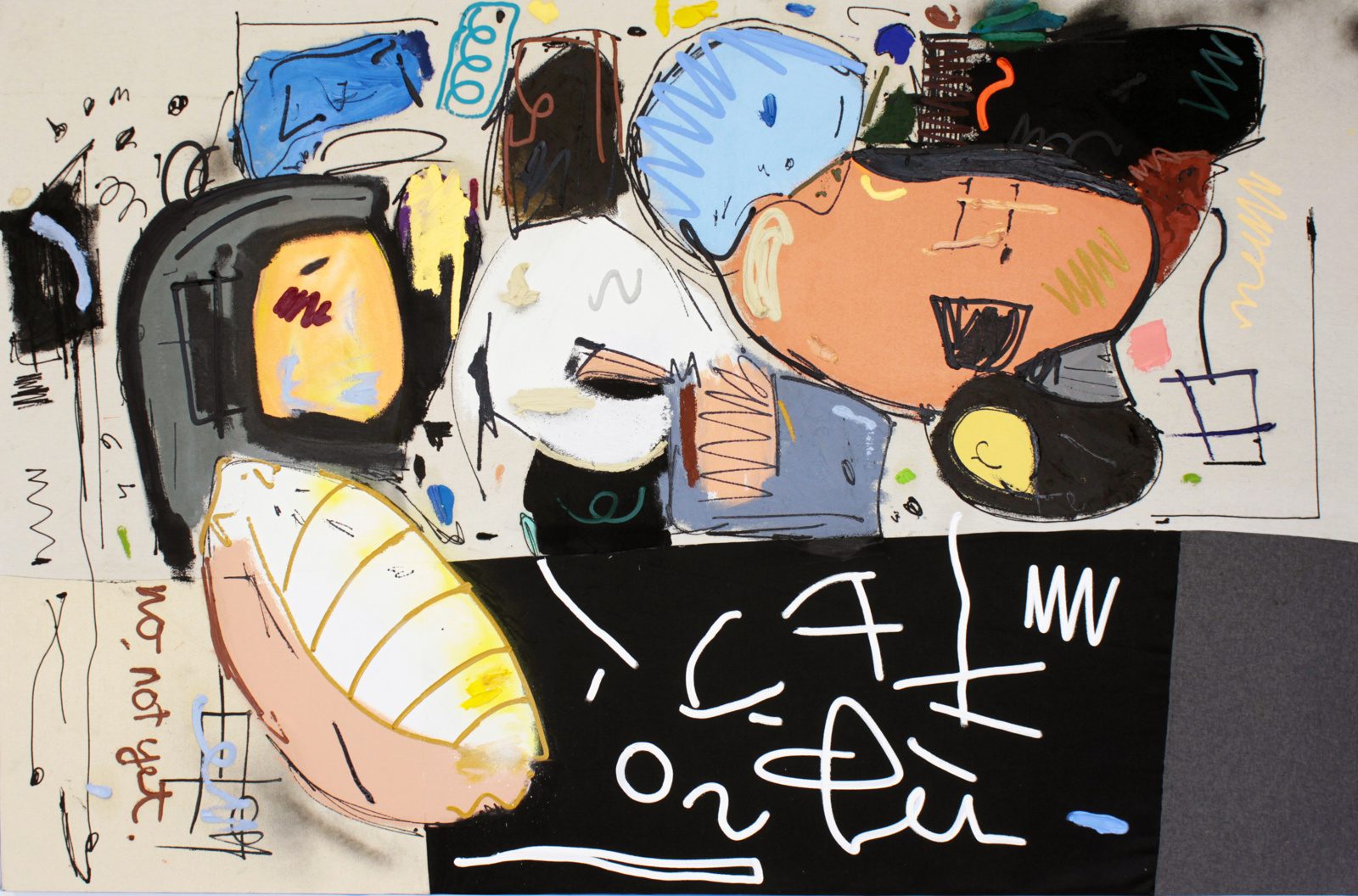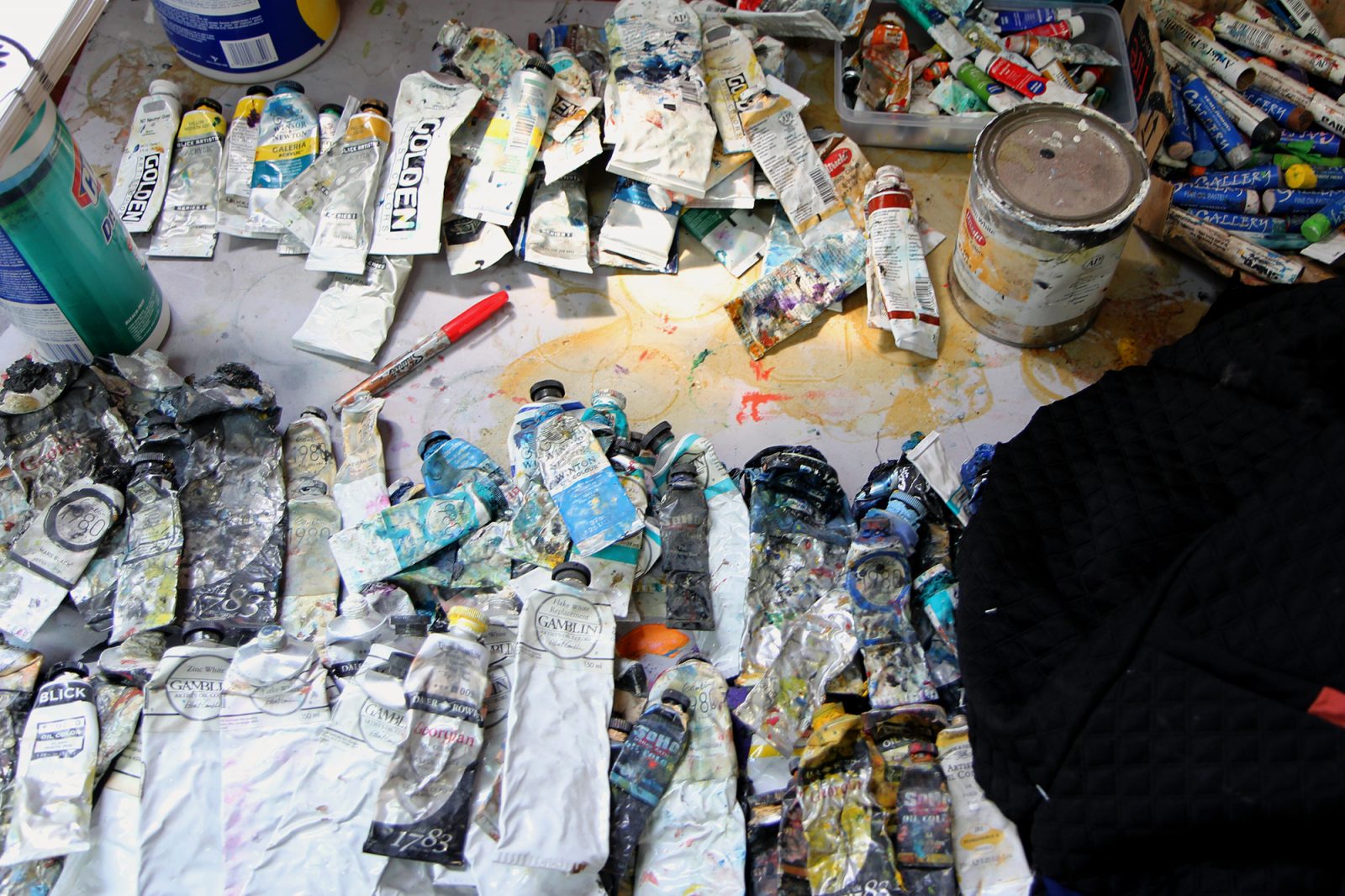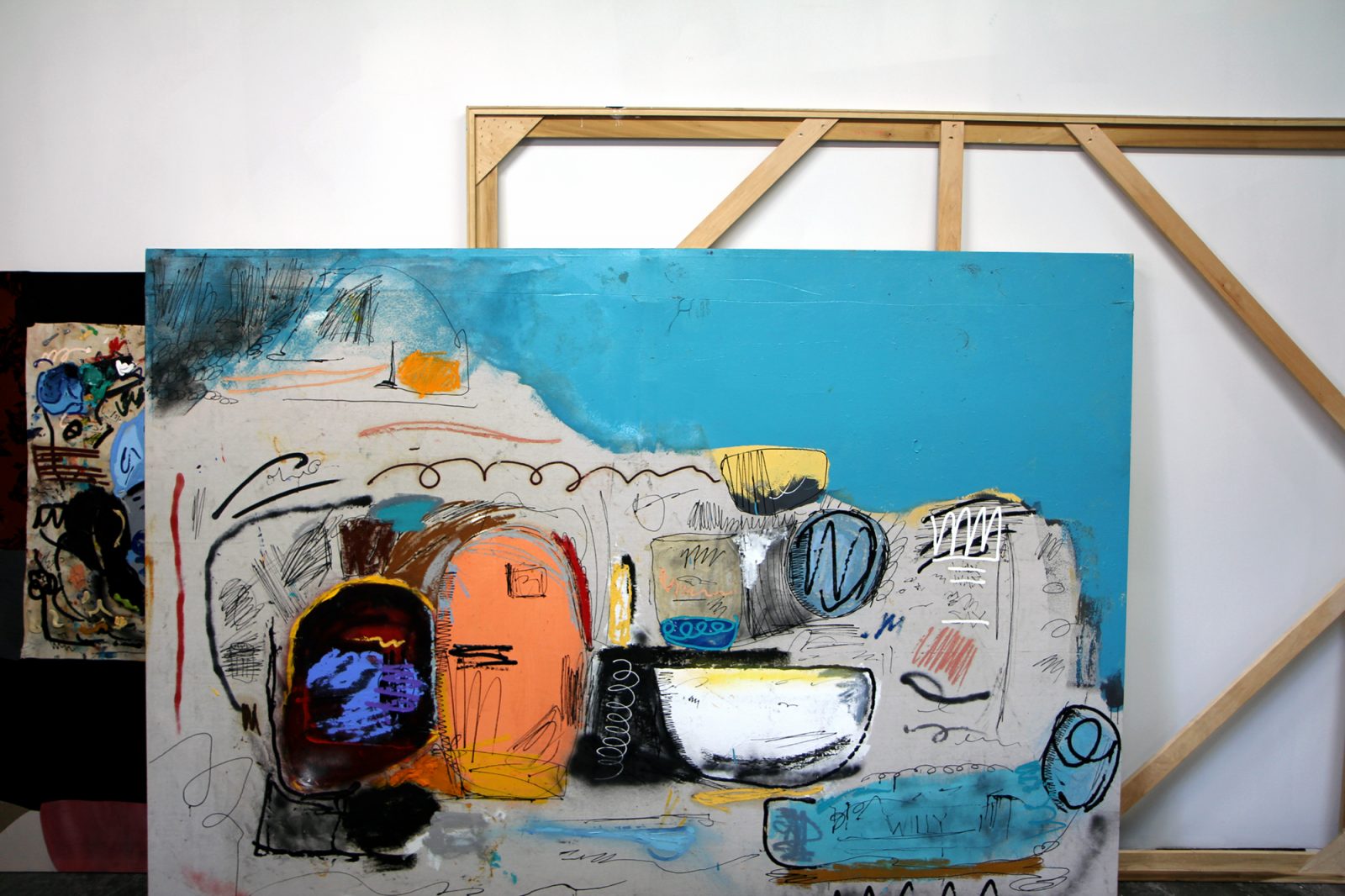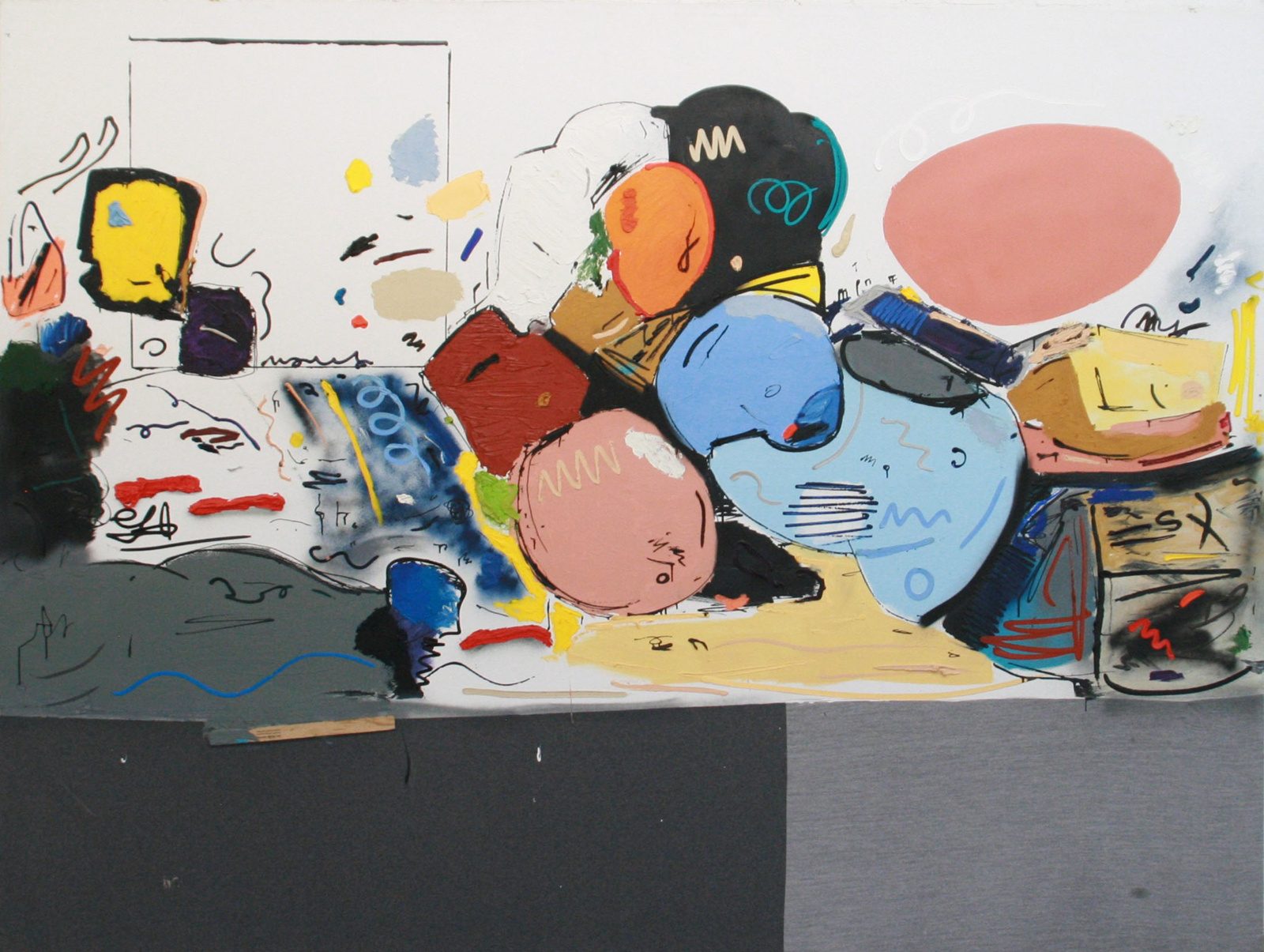Artist Nik Ewing and painter Jonni Cheatwood came to know each other’s work via Instagram and instantly connected as mutual fans of one another. Here, Nik sits down with Jonni in his studio to talk creative process, being an artist in LA and the perils and joy of being vulnerable. Read below!
Jonni Cheatwood is an internationally recognized mixed media painter from Los Angeles. Cheatwood’s work has been described as broad visual ideas stemming from still life, abstraction and minimalism. The graffiti-like scribbles, scratches and primitive colors of his work is the controlled chaotic work of an erudite, expressionist. I caught up with him at his studio in LA to learn more about how he works.
Nik: How did you first get started in art?
Jonni: I dropped out of school when I was 21—kind-of in a weird place in my life. I was working full time and I got in that habit of going to work/coming home from work. I was in a house with four other guys all still in school and was like “I need something to do” so I just started painting just to kind-of fill some void and then I got passionate about it.
N: What are you working on right now? What do you have coming up?
J: November group shows: Ivory Coast, Brisbane, NYC, London and possibly one here in LA. I have a solo show at Scope with Mika Gallery in December and a solo show in March with TW Fine Art in Australia, which is actually my first solo show out of the country.
N: How do these galleries or people approach you?
J: For some of them, friends introduce the galleries to my work. Actually most of them find me through social media—Instagram and stuff like that.
N: It’s wild. A lot of artists I know say the same thing. That they’ll be in galleries and sell a couple of things a year but now so much comes directly through social media.
J: Yeah totally. It’s weird. I’ve been approached by a lot of people who say “I like this piece, is it available?” And I wish I could just sell it directly and not have to worry about galleries taking a percentage of it. Like this piece [here] was in some gallery and I actually just got it back, it’s one of the only pieces I have that’s not consigned to someone else right now.
N: When you think about the business side to any art, like film, music or fine art, if it were any other industry, it’d be extortion or a crime. But for creatives, it’s “just the way it is.”
J: I think more so with art. I’ve always wondered, how does the whole process work of joining or playing with a band? Do you have auditions to be in a band or is it more, like “hey I know you, you’re cool”?

“Find the things that make you happy. Keep going back to the things that made you want to paint or create in the first place.”

N: Both. Like knowing someone who knows someone or having musician friends and for the lack of a better term, just “jam.” When I started playing with Local Natives I learned a few of their songs and we jammed, but it was just me playing their songs with them. Most of the audition you’re just vibing each other out. There are definitely so many more people that can play technically better than I can, but we actually liked each other and have similar taste in the art we want to make.
J: You’ve seen Selena yeah? I’ve always imagined it’s like that, like a shirtless guy with a guitar and everyone is just sitting on a couch watching him play.
N: Haha! I know there’s a bit of that in LA though, like the dark side of the industry. Art is competitive in a sense, but the overly competitive side is gross.
J: I’ve noticed there’s a lot of camaraderie within the artist community. I interact with a lot of artists on Instagram. They’re like “your stuff is awesome” and I’m like “ your stuff is awesome too” “I’m in town this week” “let’s meet up” type of thing.
N: What advice would you give to young artists?
J: Find the things that make you happy. Keep going back to the things that made you want to paint or create in the first place. I guess that’s a hard place to go, like you were saying with music, that the business of art can kind of beat you up a little bit. But if you can find that joy, then you’re ok. Having your support group is crucial, so is keeping your integrity.
Just showing up is half the battle. There are so many days where I’m like “I don’t want to paint, I don’t want to go to my studio.” I don’t know how it’s with you with music but I’m sure there are days where you’re not into it. Showing up is key. There are days where I just come here, not expecting to work or anything, just come here to like eat lunch or something and then all of a sudden I crank out two paintings and I’m like “oh shoot, I didn’t even want to show up today”.
Work like a madman. Don’t be afraid of being vulnerable. Painting is kind of an intimate thing. I’m not one for attention, but it’s a solo thing. I’m alone painting in a room a lot then I’m showing it to thousands of people and that’s kind of nerve racking. Being vulnerable used to be the most terrifying thing in the world for me.

N: Do you try to subvert any vulnerability? Like in certain works can you point to a section or color and that represents something specific in your life?
J: I actually just did one of those Ancestry DNA tests. I thought I was just black and Brazilian my whole life, just half and half. That’s not the case at all. I’m like 40% African, Scandinavian, a little bit Native American, a little bit of so many other things. So my race went from 2 to 20. And I was all “oh I’m stitched together like all these weird fabrics” and it’s kind of cheesy, but my art starts with taking these different fabrics and stitching them together and then painting on top of it. So in that sense, it’s a little bit more of an insight to who I am—stitched together. Hahaha, so corny.
N: Haha! But there is that realization that you are your work.
J: I used to try to detach myself from my work, like make it and be done with it, but then you realize that you’re just pumping stuff out and it doesn’t mean anything. When I started, everything I made was for me.
N: You were talking about chasing that joy and doing what you love, but then that becomes a business, like “I need to pay rent” or even “I’m tired of doing this for so many years and at least want to break even.” Those two things are in conflict.
J: They totally are. There’s a big difference from when you’re just doing it for fun, a little passion project. When I was doing this in college I sold a painting for $150 and that was my rent, which is crazy that my rent was only $150! Then I sold one for $20 and I was like, “this is cool!” And it’s so fun ’cause you’re not thinking $200 is changing your life. I still love what I do, but it’s like what you’re saying, once business is involved, it gets a little tricky. There’s a lot of greed in the art world but I’m just trying to navigate it as best I can and get back to where I was when I first started painting.
Back then I was bartending and now I’m back in that spot 10 years later. I like it. It gives my mind a break or takes the stress off of staring at the same thing. So I kind of feel like I’m starting over again. And it’s ok to start over, I’m realizing that too. But I’m not really starting over. Haha. I don’t know why I said that, I’m still doing fine. I have a lot of shows coming up.
N: But do you feel that way because you don’t have all your pieces to dig through right now?
J: Yeah, I have zero inventory. I have a lot of work to do in a little bit of time. And this space is smaller than I’m used to but I’ll make it work. My work has always changed in the space I’m in. I’m curious to see how it changes in this place or with these gallery things weighing over me, if it will be a big FU to art. I don’t know what it’ll be.


Comments